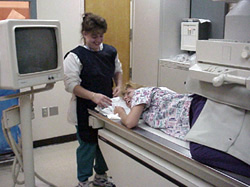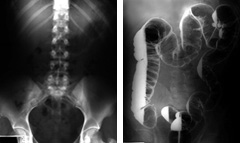
What is Fluoroscopy?
Single images of the human body captured on film are called radiographs. It also is possible to watch the body in motion by passing a continuous beam of x-rays through it, to display the images on a fluorescent screen like the one Roentgen used when he first discovered x-ray energy. Fluoroscopic images are then transmitted to a monitor by a video camera. Simply stated, fluoroscopy is watching someone's insides on TV.
The image at left is of a typical fluoroscopic room. Beneath the table top is an x-ray tube. Above the patient is an electronic tube called an image intensifier (II). The II collects the X radiation after it has passed through the patient, and creates a bright image on a small fluorescent screen. A video camera is focused on the screen to conduct the image signal onto the monitor.
There are many times when seeing a body part in motion is necessary. For an examination of the stomach, the patient must drink a substance (barium), that coats the stomach and makes it show up especially well. Under fluoroscopic control, the barium is visualized passing through the esophagus, into the stomach and out of the stomach as it is churned toward the small intestine.
Other uses of fluoroscopy include: removal of a foreign body (such as a sewing needle in the foot), needle placement for the injection of a medication, and a variety of surgical procedures.

The radiograph on the left is a plain film of the abdomen.
The radiograph on the right is the same, except the large intestine is filled with barium and air. For this particular film, the patient was lying on his side, which is why the barium (white) looks like it is standing in vertical columns.






